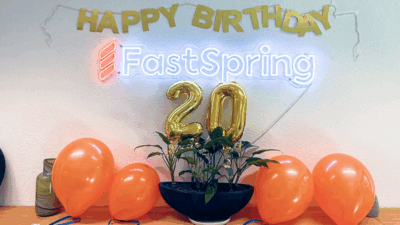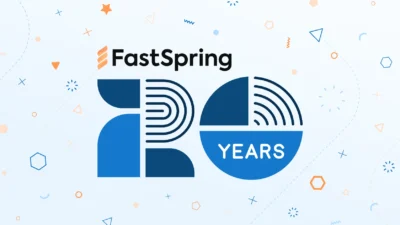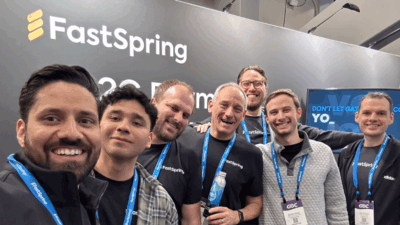A customer-centric approach is necessary for any thriving business. Not only does it support revenue goals, but it also influences employee satisfaction which can have an impact on overall company performance. In fact, 73% of employees report their job is more meaningful at companies where customer satisfaction is a key priority.
The success of our customers is central to our culture at FastSpring. It influences every aspect of our business. From product and engineering to sales and marketing, and everything in between.
I recently had the opportunity to speak at Gainsight’s Pulse Conference where I shared how FastSpring built a customer-centric culture focused on customer success. Keep reading to learn about a practical approach to infusing customer success across your organization.
What does it mean to have a customer-centric culture?
A customer-centric culture is an approach to doing business that focuses on providing a seamless and positive customer experience throughout the entire customer lifecycle. The heart of a customer-centric culture is dependent on customer empathy. It is the ability to understand the needs of the customer and the reasoning behind those needs in order to respond to it effectively.
In preparation for my presentation, I sent out an internal survey to my colleagues about customer-centricity at FastSpring, and I received a lot of great answers. Take a look at the quote below from our VP of Marketing that perfectly sums up the responses I received.
A customer-centric culture means putting the customer at the core or center of the organization, across every department, in order to create a positive customer experience at every step of the journey.
– Sarah Bottorff
VP of Marketing at FastSpring
Every organization is going to have its own way of incorporating customer-centricity into their DNA. However, the empathetic nature needs to be consistent with regular check-ins to make sure it is still a consideration in all major business decisions.
How to build a customer-centric culture to fuel customer success.
There are countless ebooks, blog posts, and guides espousing the key elements that drive a culture of customer success. The elements of a customer success culture typically include:
- CEO buy-in
- Dedicated Company Value
- CS VP-Level Leadership
This is a great start, however, executive buy-in simply isn’t enough. You really need complete company buy-in to foster a customer-centric culture. This is often easier said than done because of two main factors:
- Fast-growth environments pose a challenge when trying to align customer success with the rest of the company. Each functional area—every department and team—are evolving their own processes which can make it a challenge to get alignment.
- The “proximity to the customer” makes it more challenging for specific departments to relate to the customers when they are not in direct contact with them.
So the question becomes, how do you create and enforce a customer-focused philosophy for the entire company and how do you bring the customer closer to all areas of the business?
The answer lies in a focus on the customer experience.
The customer experience is the strategy behind creating a culture of customer success. It entails each touch point throughout the customer lifecycle. Each step in the journey has the potential to leave a positive or negative impression on the customer. The customer experience is the great unifier since every department is involved in at least one touchpoint, whether directly or indirectly.
Three steps for improving the customer experience.
Processes intended to improve the customer experience resonate with everyone and help break down the silos between departments. Here are three steps you can take in order to develop cross-departmental processes that improve the customer experience and fuel a customer-centric culture.
1. See it
The first step in this process is to have a clear understanding of the current experience for customers. A great place to start is inside-out where you gather the information from all areas and build a touchpoint map that serves as a universal guide for the customer experience. Once you have an agreed upon touchpoint map you’re ready to start measuring.
2. Measure it
The next step in the process is to measure the experience. It is important to have the right data feeding in from all of your marketing, sales, and platform tools in order to understand how customers are progressing through the milestones in the touchpoint map. Measuring the milestones is the most important step that you can take to unify the team and become truly customer-centric.
3. Improve it
Once you are able to use your data to identify the areas of improvement on your touchpoint map, the next step is to work on improving your processes to enhance the customer experience. Go through the areas identified as needing improvement in the touchpoint map and start defining what actionable improvements can be made to help with the overall experience. Some ideas to help you in this process include:
- Start with the ideal customer experience. What are the minimum critical steps that the customer needs to take in order to achieve their desired result with the product? Narrow it down to the essentials and work from there.
- Brainstorm initiatives that can help achieve a better customer experience. It’s best if you can get every department in the room to help with the brainstorming process. This way you are able to spread the efforts across multiple resources and make sure everything aligns with helping the customer succeed.
- Prioritize initiatives based on the potential impact to a measurable goal. If your goal is to achieve more conversions or increase usage, make sure your initiatives line up with what will provide the most powerful impact. This will help the teams coordinate on timelines and priorities with other projects.
It’s important to remember that all of this is an iterative process. It’s normal to have some trial and error involved as long as there is overall alignment around the customer experience. The key is to maintain your focus on the customer experience and putting the customer at the forefront of your culture.
![[Customer Story] Why TestDome Considers FastSpring a Real Partner](https://fastspring.com/wp-content/themes/fastspring-bamboo/images/promotional/2023/FastSpring-TestDome-blog-thumbnail.jpg)








